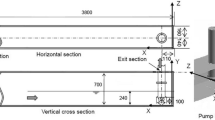Abstract
The head-capacity curves for pumps developed by the pump manufacturer are based on tests of a single pump operation in a semi-infinite basin with no close walls or floors and with no stray currents. Therefore, flow into the pump intake is with no vortices or swirling. However, pump station designers relying on these curves to define the operating conditions for the pump selected sometimes experience reductions of capacity and efficiency, as well as the increase of vibration and additional noise, which are caused by free air mixed with the pump inlet flow. Therefore, sump model test is necessary in order to examine the flow structure around pump intake. In this study, flow uniformity according to the flow distribution in the pump intake channel is examined to find out the cause of vortex occurrence in detail. A multi-intake pump sump model with 7 pump intakes and a single-intake pump sump model are adopted for the investigation. Furthermore, effectiveness of anti-submerged vortex device (AVD) for the suppression of the vortex occurrence in a single pump intake, as well as in a multi-intake pump sump model has been examined by the methods of experiment and numerical analysis. The results show that most high value of flow uniformity is found at the inlet of pump intakes #3 and 5 in the multi-intake pump sump with 7 pump intakes. Therefore, when the pump station is designed, the flow patterns at the upstream region of pump intake inlet in the forebay diffusing area should be to consider in detail because the unbalanced flow at the channel inlet region gives considerable influence on the vortex occurrence around bell-mouth. Strong submerged vortex can be successfully suppressed by AVD installation on the bottom of pump intake channel just below the bell mouth.
Similar content being viewed by others
References
M. Padmanabhan and G. E. Hecker, Scale Effects in Pump Models, ASCE J. Hydraulic Engineering, 110(11) (1984) 1540–1556.
V. P. Rajendran, S. G. Constantinescu and V. C. Patel, Experiments on Flow in Model Water-pump Intake Sump to Validate a Numerical Model, Proc. of ASME Fluids Engineering Division Summer Meeting, (1998) FEDSM98-5098.
K. Kamemoto, K. Suzuki and T. Mugiyama, An Experimental Study on Similarity of Vortex Formation Characteristics in Two Different Scale Models of Pump Sump, Proc. of the 9th Asian International Conference on Fluid Machinery, (2007) No. AICFM9-235.
T. Nagahara, T. Sato and T. Okamura, Measurement of the Flow around the Submerged Vortex Cavitation in a Pump Intake by Means of PIV, Proc. of Fifth International Symposium on Cavitation, (2003) Cav03-OS-6-011.
Y. H. Lee, Establishment of Design Guideline for the Pump Intake Shape using the Result of Model Test, R&D Report, K-water (in Korean) (2004).
Turbomachinery Society of Japan, Standard Method for Model Testing the Performance of a Pump Sump, TSJ S002, (2005).
R. B. Abernethy, R. P. Benedict and R. B. Dowdell, ASME Measurement Uncertainty, ASME J. Fluids Eng. 107 (1985) 161–164.
Hydraulic Institute, Pump Intake Design, ANSI/HI 9.8-1998, (1998).
ANSYS-CFX Documentation Ver. 11, ANSYS Inc., (2007).
F. R. Menter, M. Kuntz and R. Langtry, Ten Years of Industrial Experience with the SST Turbulence Model, Proc. of the Fourth International Symposium on Turbulence, Heat and Mass Transfer, Begell House, Redding, CT, (2003).
Author information
Authors and Affiliations
Corresponding author
Additional information
This paper was recommended for publication in revised form by Associate Editor Yang Na
Jong-Woong Choi received his B.E. and M.E. degrees in Mechanical Engineering from Korea Maritime University, Korea in 2001 and 2003, respectively. Mr. Choi is currently a doctorate student in the Department of Mechanical Engineering, Graduate School, Korea Maritime University. His research interest includes fluid machinery, ocean energy, wind energy.
Young-Do Choi received his B.E. and M.E. degrees in Mechanical Engineering from Korea Maritime University, Korea in 1996 and 1998, respectively. He received his Ph.D. in Engineering from the Yokohama National University, Japan in 2003. Dr. Choi is currently a professor at the Department of Mechanical Engineering, Mokpo National University, Korea. His research interests include fluid machinery, ocean energy, wind power, small hydro power.
Chang-Goo Kim received his B.E. and M.E. degrees in Mechanical Engineering from Korea Maritime University, Korea in 2007 and 2009, respectively. Mr. Kim is currently a doctorate student in the Department of Mechanical Engineering, Graduate School, Korea Maritime University. His research interest includes fluid machinery, ocean energy.
Young-Ho Lee received his B.E. and M.E. degrees from Korea Maritime University, Korea. He received his Ph.D. in Engineering from the University of Tokyo, Japan. Dr. Lee is currently a Professor at the Division of Mechanical and Information Engineering, Korea Maritime University. His research interests include fluid machinery, ocean energy, wind energy, small hydro power, PIV, and CFD.
Rights and permissions
About this article
Cite this article
Choi, JW., Choi, YD., Kim, CG. et al. Flow uniformity in a multi-intake pump sump model. J Mech Sci Technol 24, 1389–1400 (2010). https://doi.org/10.1007/s12206-010-0413-5
Received:
Revised:
Accepted:
Published:
Issue Date:
DOI: https://doi.org/10.1007/s12206-010-0413-5




